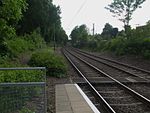Ashburton Playing Fields
AC with 0 elementsParks and open spaces in the London Borough of Croydon

Ashburton Playing Fields is a playing field located in Woodside, London. It is managed by the London Borough of Croydon. The fields are bordered by Bywood Avenue in the north, Chaucer Green in the west and Woodville Avenue in the east. Stroud Green Way backs onto the western boundary. Tramlink services for the park are Arena and Woodside. It covers an area of 49.5 acres (20 ha).Facilities include football and cricket pitches, changing rooms, and children's playground. The fields are open 24 hours per day throughout the year, although pitches and use of changing rooms have to be booked in advance.
Excerpt from the Wikipedia article Ashburton Playing Fields (License: CC BY-SA 3.0, Authors, Images).Ashburton Playing Fields
Woodmere Avenue, London Shirley (London Borough of Croydon)
Geographical coordinates (GPS) Address Nearby Places Show on map
Geographical coordinates (GPS)
| Latitude | Longitude |
|---|---|
| N 51.3844 ° | E -0.0546 ° |
Address
Woodmere Avenue
Woodmere Avenue
CR0 7PH London, Shirley (London Borough of Croydon)
England, United Kingdom
Open on Google Maps







